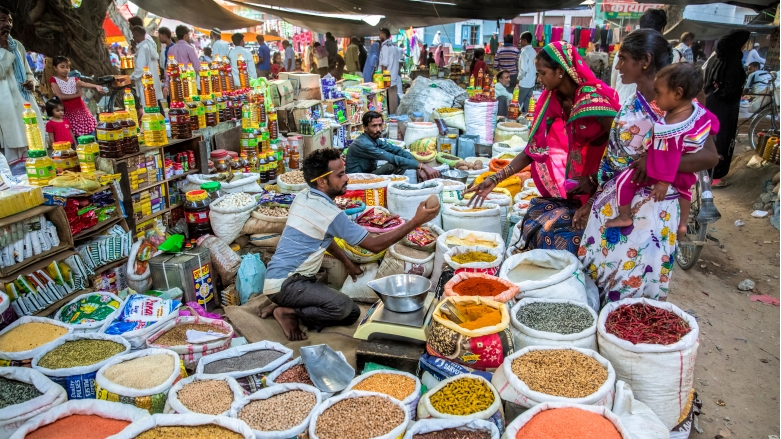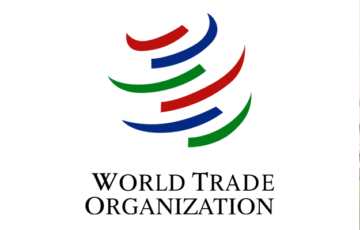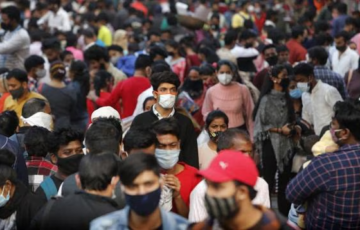PUBLIC DISTRIBUTION SYSTEM
Public Distribution System (PDS) in India
- The Public Distribution System (PDS) in India is a government-run program aimed at distributing food grains and other essential commodities at subsidized prices to underprivileged sections of society. Operated under the Union Ministry of Consumer Affairs, Food, and Public Distribution, PDS plays a crucial role in the government’s efforts to manage the food economy and ensure food security across the country. It is a joint responsibility of the Central and State/Union Territory Governments, with the former handling procurement, storage, and bulk allocation, and the latter managing distribution to eligible families through Fair Price Shops (FPSs).
Background of PDS
Evolution from Universal to Targeted System
- Before 1992: PDS was a universal entitlement program without demographic targeting.
- 1992: Transition to Revamped PDS (RPDS), focusing on impoverished households in remote and difficult-to-reach areas.
- 1997: RPDS evolved into Targeted PDS (TPDS), with Fair Price Shops providing food grains at discounted prices.
Judicial and Legislative Support
- Supreme Court Ruling: The “right to food” is integral to the right to life (Article 21 of the Constitution).
- National Food Security Act (NFSA) 2013: Aims to make the right to food a legal entitlement for approximately two-thirds of the population using the TPDS framework.
Objectives of PDS
- Provide food grains and essentials at subsidized prices to vulnerable groups.
- Moderate open market prices of cereals and essential commodities.
- Ensure fair distribution and availability of food grains at a reasonable cost.
- Socialize the distribution of necessities.
Importance of PDS
- Increases food grain production through minimum support price and procurement.
- Ensures food and nutritional security.
- Maintains buffer stocks for crisis times.
- Stabilizes food prices by distributing excess food to deficient regions.
Functioning of PDS
- Central Role: Procurement at Minimum Support Price (MSP), maintenance of buffer stocks, and allocation to states at central issue prices.
- State Role: Transportation from godowns to FPSs and sale to beneficiaries at subsidized rates. Many states further subsidize prices.
Issues Associated with PDS
- Production vs. Procurement Dilemma: Dependency on rice and wheat imports during shortages.
- Allocation and Offtake Discrepancies: Significant leakage into the free market.
- Identification of Beneficiaries: Inclusion and exclusion errors, with eligible beneficiaries often missing out.
- Ghost Cards: Existence of cards for non-existent beneficiaries leading to diversion of grains.
- Storage Capacity Challenges: Uneven distribution and underutilization of storage capacities across states.
- Food Grain Leakage: Substantial leakages during transportation to FPSs and into the open market.
Reforms for PDS
- Integration with Aadhaar: To improve beneficiary identification and reduce errors.
- Shanta Kumar Committee Recommendations: Focus on enhancing FCI’s efficiency and storage capabilities.
- Cash Transfers: Cautious implementation advised by RBI and emphasized for improved infrastructure by the Economic Survey.
- Technology-based Reforms: Successful in reducing leaks and ensuring proper distribution in states like Haryana, Andhra Pradesh, and Odisha.
Improving the Efficiency of the Public Distribution System (PDS)
- The Public Distribution System (PDS) plays a crucial role in ensuring food security for the underprivileged sections of society. However, to maximize its effectiveness, certain measures need to be implemented:
Decentralized Procurement
- Local Procurement and Distribution: Encouraging states to procure and distribute locally produced food grains can ensure the preservation of food grain diversity and adapt to local needs more effectively.
Proper Categorization of Beneficiaries
- Accurate Identification: Implementing a foolproof system for identifying and categorizing beneficiaries (APL, BPL, or AAY households) is vital to targeting the benefits accurately and avoiding leakages to bogus beneficiaries.
Incentivizing Fair Price Shops (FPSs)
- Enhanced Operation: Some states, like Delhi, have successfully motivated FPS owners by allowing them to operate for longer hours and sell non-PDS items, ensuring better availability and service to beneficiaries.
Adaptation to Climate Change
- Climate-Resilient Crops: Emphasizing the adoption of climate-resilient agricultural practices and crops to ensure sustainable food production in the face of changing climate patterns.
Technology-based Reforms
- System Improvements: States that have embraced computerization and other technology-based reforms have shown success in reducing leakages and improving the distribution efficiency of the TPDS.
Universal PDS
- Avoiding Beneficiary Selection Errors: Implementing a universal PDS can eliminate errors in targeting and classification, as evidenced by the success of states like Tamil Nadu.
Food Coupons
- Flexibility for Beneficiaries: Providing food coupons to beneficiaries allows them the freedom to purchase food grains from any retailer, which could potentially streamline the distribution process and empower consumers.
Case Study: e-PDS in Chhattisgarh
- Real-Time Monitoring: Chhattisgarh’s e-PDS project incorporates real-time GPS tracking from depots to FPSs, significantly contributing to the state’s PDS efficiency.
Food Security and Global Hunger Index (GHI)
Definition of Food Security
- Comprehensive Access: According to the UN Committee on World Food Security, food security is achieved when all people have continuous access to sufficient, safe, and nutritious food that meets their dietary needs for an active and healthy life.
Importance of Food Security
- Global Hunger Challenges: The dramatic increase in global hunger, exacerbated by the COVID-19 pandemic, underscores the critical need for robust food security measures. India, with a significant portion of the world’s undernourished population, faces urgent challenges in this regard.
Global Hunger Index (GHI)
- Measuring Hunger: The GHI is a tool designed to comprehensively measure and track hunger at global, regional, and national levels, aiming to raise awareness and direct efforts where they are most needed.
- GHI Indicators: Hunger levels are assessed using four indicators: undernourishment, child wasting, child stunting, and child mortality.
- Scoring System: The GHI scores range from 0 (no hunger) to 100 (extreme hunger), with countries classified into severity categories based on their scores.
Challenges Highlighted by the GHI
- India’s Position: India’s ranking in the GHI (107 out of 121 countries in 2022) reflects significant challenges in combating hunger and malnutrition, necessitating targeted efforts to improve food security.
Suggestions for Enhancing PDS Efficiency
- To enhance the PDS’s efficiency and ensure food security, a multifaceted approach involving strategic planning, technological integration, and policy reform is essential. Measures such as adopting a decentralized procurement system, incentivizing FPS operations, incorporating climate-resilient agricultural practices, and leveraging technology for system transparency and efficiency can collectively address the challenges faced by the PDS. Additionally, a universal approach to PDS, coupled with innovative solutions like food coupons, can significantly improve accessibility and reduce leakage, ensuring that the benefits reach the intended beneficiaries effectively.
NATIONAL FOOD SECURITY ACT (NFSA) 2013
- The National Food Security Act (NFSA), 2013, marks a significant step in India’s endeavor to eliminate hunger and ensure food security for its population.
Provisions of NFSA
- Scope and Coverage: The NFSA aims to provide access to quality food in sufficient quantities at affordable prices for people to live a life with dignity. It covers 75% of the rural population and 50% of the urban population under the Targeted Public Distribution System (TPDS), reaching approximately 67% of India’s total population.
- Categories of Beneficiaries: There are two main categories of beneficiaries under NFSA – Antodaya Anna Yojana (AAY) households, who are the poorest of the poor, and Priority Households, who require food security assistance but are above the AAY cut-off.
- Entitlements: AAY households are entitled to 35 kg of food grains per month, while Priority Households receive 5 kg of food grains per person per month.
- Woman as the Household Head: The Act mandates that the oldest woman in the household, aged 18 or above, is considered the ‘Head of the Family’ for the purpose of issuing ration cards.
- Grievance Redressal Mechanisms: The NFSA provides for grievance redressal mechanisms at the district and state levels to address any issues arising under the Act.
Significance of NFSA
- Agricultural Benefits: By guaranteeing a market for their produce, NFSA supports the agricultural sector, potentially leading to more employment opportunities in this labor-intensive sector.
- Price Control: The Act plays a role in stabilizing food prices by regulating supply and demand through its distribution mechanisms.
- Health and Economic Stability: Access to quality food is expected to improve public health, contributing to the overall economic stability and security of the country by ensuring a healthy workforce.
Criticisms of NFSA
- Impact on Farmers: Critics argue that NFSA could nationalize agriculture, diminishing the bargaining power of marginal and small farmers, and potentially disrupting market dynamics.
- Inefficiencies in Distribution: The involvement of private entities and the potential for leakages and corrupt practices in the PDS and supply chain are seen as barriers to the effective operation of the Act.
- Nutritional Aspects Neglected: Although the Act addresses hunger, it is criticized for not adequately addressing issues of undernutrition and ensuring the right to nutrition.
NFSA and Women
- Nutritional Support: The Act, through the ICDS and MDM programs, provides nutritional support to children, pregnant women, and nursing mothers, with enhanced provisions for malnourished children.
- Maternity Benefit: Pregnant and nursing mothers are entitled to a maternity benefit of Rs. 6,000, underlining the Act’s focus on maternal health.
- Empowerment: By designating the oldest woman as the household head for ration card distribution, the Act promotes women’s empowerment within the family structure.
Recent Developments and Suggestions
- Revision of Central Issue Prices (CIP): The Economic Survey 2020-21 suggested revising the CIP of food grains to reflect current economic realities.
- Adjustment in Coverage Ratios: A NITI Aayog discussion paper recommended adjusting the rural and urban coverage ratios to 60% and 40%, respectively, which would change the number of beneficiaries and potentially lead to significant savings that could be redirected towards other critical areas like health and education.
One Nation One Ration Card Scheme (ONORC)
Objective
- Facilitates food security for NFSA beneficiaries, especially migrants, by allowing them to access their entitled food grains from any Fair Price Shop in India, enhancing self-reliance in food security.
Ministry
- Launched by the Ministry of Consumer Affairs, Food and Public Distribution in 2019.
Benefits
- Subsidized Food Grains: Ensures that NFSA beneficiaries, particularly migrants, receive their entitled food grains.
- Addresses Massive Internal Migration: Helps understand migration patterns through centralized shop data.
- Prevents Double Beneficiaries: Aids in reducing the instances of individuals holding multiple ration cards.
- Improves Food Distribution Systems: Addresses the issue of food grain wastage.
BUFFER NORMS
- Buffer norms and strategic reserves are essential components of a country’s food security strategy, ensuring stability in food prices and supply. These policies aim to mitigate the impact of fluctuations in production and prices, thereby protecting both consumers and producers.
Buffer Norms and Strategic Reserves
- Determination of Norms: The Cabinet Committee on Economic Affairs sets the minimum buffer standards four times a year: at the beginning of April, July, October, and January.
- Strategic Reserve: As of July 1, 2008, and January 1, 2009, the Indian government mandated a strategic reserve of 30 lakh tonnes of wheat and 20 lakh tonnes of rice, respectively, in addition to buffer limits.
- Food Grain Stocking Norms: Currently referred to as the amount of stock in the Central Pool that is sufficient to meet operating requirements for food grains and address exigencies.
Objectives of Maintaining Buffer Stocks
- Stabilizing Prices: Ensures farmer revenues are maintained by keeping prices stable, thereby preventing structural unemployment and encouraging more investment in agriculture.
- Consistent Supply: Helps maintain food supplies and prevent shortages.
- Welfare Programs: Supports efficient management of welfare programs through Public Distribution systems.
Challenges
- Increase in Inventory Cost: Excess purchase of grains leads to higher inventory costs and waste due to inadequate storage facilities.
- Increasing Procurement Cost: Rising Minimum Support Prices (MSP) increase the overall procurement costs for the Food Corporation of India (FCI).
- Soaking Up Surplus Stockpile: Policies may encourage overproduction and excessive use of chemicals, knowing that any surplus will be purchased.
Shanta Kumar Committee Recommendations
- Outsourcing Stocking Operations: FCI should outsource its stocking operations to reduce storage costs and improve efficiency.
- Bulk Handling Facilities: More bulk handling facilities and better mechanization in silos and conventional storages are needed.
- Phasing Out CAP Storage: Covered and plinth (CAP) storage should be phased out to ensure no grain stocks stay beyond three months.
- Containerized Movement of Grains: To reduce transit losses and improve turnaround time through more mechanized facilities at railway sidings.
Buffer Stock System
- A buffer stock system purchases and stores stocks during good harvests to prevent price drops and releases stocks during poor harvests to avoid price spikes. It also minimizes food shortages caused by natural calamities.
Conclusion and Way Forward
- Improving the Targeted Public Distribution System (TPDS) involves several steps such as door-to-door delivery of food grains, correct identification of beneficiaries, and increased monitoring and vigilance. A need-based PDS system is vital not only for reducing the subsidy bill but also for minimizing leakages. Political will is crucial for removing inefficiencies in the PDS and enhancing food security.
UPSC PREVIOUS YEAR QUESTIONS
1. With reference to the provisions made under the National Food Security Act, 2013, consider the following statements: (2018)
1. The families coming under the category of ‘below poverty line (BPL)’ only are eligible to receive subsidised food grains
2. The eldest woman in a household, of age 18 years or above, shall be the head of the household for the purpose of issuance of a ration card.
3. Pregnant women and lactating mothers are entitled to a ‘take-home ration’ of 1600 calories per day during pregnancy and for six months thereafter.
Which of the statements given above is/are correct?
(a) 1 and 2 only
(b) 2 only
(c) 1 and 3 only
(d) 3 only
2. What are the salient features of the National Food Security Act, 2013? How has the Food Security Bill helped in eliminating hunger and malnutrition in India? (2021)
3. What are the reformative steps taken by the Government to make the food grain distribution system more effective ? (2019)










